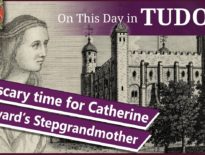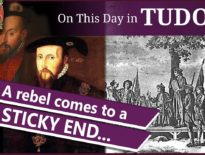On this day in Tudor history, 8th December 1538, courtier and Master of the Horse to Queens Anne Boleyn and Jane Seymour, Sir William Coffin, died at Standon in Hertfordshire.
It is thought that he died of the plague because his wife Margaret wrote to Thomas Cromwell saying that Coffin had “died of the great sickness, full of God’s marks all over his body”.
Who was Sir William Coffin and what did the Master of the Horse do?
Find out in today's talk.
Trivia: Coffin's wife was one of Queen Anne Boleyn's ladies when she was imprisoned in the Tower of London in 1536.
Also on this day in Tudor history, 8th December 1542, Mary, Queen of Scots, was born at Linlithgow Palace in Scotland. She was the daughter of King James V of Scotland and his second wife, Marie de Guise, and she became Queen of Scotland when she was just six days old. You can find out about her life, including her three marriages and abdication, her imprisonment and downfall, in last year’s talk:
Also on this day in history:
- 1558 – Death of Hugh Weston, Dean of Windsor, at William Wynter's house in Fleet Street, London. He was buried at the Savoy. Weston had just been released from imprisonment in the Tower of London due to his ill health. He had been deprived of his deanery for alleged indecency in August 1557, and was arrested at Gravesend while he was on his way to Rome to appeal against his deprivation.
Transcript:
On this day in Tudor history, 8th December 1538, Sir William Coffin, courtier and Master of the Horse to Queens Anne Boleyn and Jane Seymour, died at Standon in Hertfordshire.
It is thought that he died of the plague because his wife Margaret wrote to Thomas Cromwell saying that Coffin had “died of the great sickness, full of God’s marks all over his body”. He was buried at the parish church in Standon and in his will he left his hawks and best horses to the king.
Let me tell you a bit more about this Tudor Master of the Horse, but first let me explain what a Master of the Horse was…
In Henry VIII’s reign, the royal household was divided into three departments presided over by the three great officers: the Lord Chamberlain, the Lord Steward and the Master of the Horse, who were all appointed by the king. While the Lord Chamberlain was in charge of the King’s Chambers, the privy chamber and Great Chamber, and the Lord Steward was in charge of the household below stairs, including the kitchens, grounds and gardens, the Master of the Horse, would have been in charge of the king’s horses and stables, and all those who worked there, and also the king’s hunting dogs. He would provided horses for war and for travel, and also would have had a ceremonial role at events like coronations.
The queen’s household was divided in a similar manner. We know, for example, that Queen Anne Boleyn had Thomas Lord Burgh as her Lord Chamberlain, with Sir Edward Bayntun as her vice-chamberlain, and Coffin as her Master of the Horse. While Sir Nicholas Carew served Henry VIII as his Master of the Horse, Coffin was in charge of the queen’s horses and attending her on special occasions.
But who was William Coffin?
William Coffin was born by 1492, probably at Porthledge in Devon, and was the son of Richard Coffin and his wife, Alice Gambon. He first served King Henry VIII as a petty captain in the king’s 1513 French campaign. He joined King Henry VIII’s privy chamber in 1515 and later that year was part of an embassy that went to Flanders.
In 1517, Coffin wanted to marry the recently widowed Margaret Vernon. Margaret was the daughter of Sir Robert Dymoke of Lincolnshire, and the widow of Richard Vernon, son and heir of Sir Henry Vernon of Haddon, who had died in 1515. When Vernon died in 1517, he left Margaret a wealthy woman. The wardship of their son, George, was held by Cardinal Wolsey. Wolsey was planning to arrange a marriage between Margaret and his servant, Sir William Tyrwhit, but Coffin was able to get Sir Nicholas Carew to intercede with the king on his behalf and he married Margaret. The marriage appears to have been childless.
By 1519, Coffin was one of Henry VIII’s gentleman ushers, and while he attended the king at the Field of Cloth of Gold in 1519, his wife served as one of Catherine of Aragon’s gentlewomen. Coffin also served the king at his meeting with Emperor Charles V at Gravelines in 1520. In that same year, the king rewarded him with the keepership of Combe Martin Park in Devon.
Following his marriage to Margaret, Coffin moved his home from Devon to Derbyshire, and served as a Member of Parliament for the county in 1529, a Justice of the Peace from 1524 until his death, and as sheriff of Nottinghamshire and Derbyshire in 1531 and 1532.
By 1526, Coffin had become sewer of the chamber and he served as Anne Boleyn’s Master of the Horse at her coronation in 1533. In May 1536, after Queen Anne Boleyn’s arrest, Coffin’s wife, Margaret, one of the women appointed by Cromwell to serve Anne Boleyn while she was imprisoned in the Tower of London. The women were not ladies Anne would have chosen and Anne complained to Sir William Kingston, Constable of the Tower, saying “I thynke [much unkindness in the] Kynge to put seche abowt me as I never loved”. The ladies appointed were ordered not to speak to Anne unless Lady Kingston, the Constable’s wife, was present to remember or record what was said. They were to act as spies really.
Following Anne Boleyn’s execution and Henry VIII’s subsequent marriage to Jane Seymour, Coffin continued his service as Master of the Horse to the new queen, and in May 1537 he was sworn in as a knight of the privy chamber, being dubbed in October 1537, following the birth of Prince Edward, the future Edward VI.
In late 1536, during the Pilgrimage of Grace rebellion, Coffin worked for George Talbot, 4th Earl of Shrewsbury, and was involved with interrogating rebels.
On this day in history, 8th December 1538, the same day that he made his will, William Coffin died at the manor of Standon in Hertfordshire, which he’d just been made bailiff of. He named his wife, Margaret, as his executor and she inherited his goods and leases, while his nephews inherited his Devonshire lands and two servants inherited his lands in Bakewell, Derbyshire. Margaret went on to marry Sir Richard Manners in 1539 and she died in 1550.



Leave a Reply